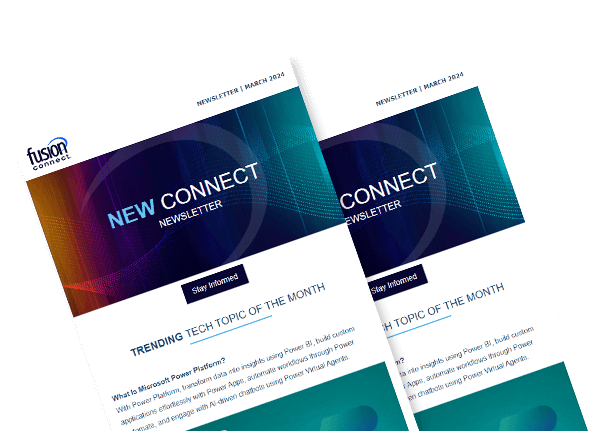Power Apps vs Power Automate
Understanding Power Apps and Power Automate
Posted on December 6, 2023 by Fusion Connect
In the dynamic world of Microsoft Office 365, two standout tools are reshaping how businesses approach task automation and app development: Power Apps and Power Automate.
While both platforms offer robust capabilities, understanding their distinct features and applications is crucial for technical Microsoft admins and senior business users alike.
This blog delves into the nuances of Power Apps and Power Automate, helping you make an informed decision on which tool best suits your organizational needs.

What is Microsoft Power Apps?
Microsoft Power Apps is a revolutionary low-code platform that empowers businesses to create custom applications tailored to their specific needs.
With Power Apps, even those with minimal coding experience can design and deploy apps across a variety of platforms, including mobile devices, desktop computers, and web browsers.
Its seamless integration with other Microsoft products like SharePoint and Dynamics 365 makes it an ideal solution for businesses seeking to enhance their internal app development capabilities without extensive resource investment.
What is Microsoft Power Automate?
Microsoft Power Automate (formerly known as Microsoft Flow) is designed to automate repetitive tasks and streamline business processes.
This tool enables the creation of automated workflows between various applications and services - think of automating email notifications or syncing files between applications.
Power Automate is particularly effective for businesses looking to reduce time spent on mundane tasks, thereby boosting efficiency and productivity.
Key Differences
Editing and Improvements
One of the primary distinctions between Power Apps and Power Automate lies in their approach to editing and improvements. Power Apps allows direct, real-time editing within its platform, offering a more agile and responsive app development experience.
In contrast, Power Automate utilizes a separate tool called Flow for editing workflows, which, while powerful, may not offer the same immediacy in updates and changes.
Adaptability and Versatility
When it comes to versatility, Power Apps takes the lead. It supports usage across various devices and integrates more extensively with other Microsoft products.
Power Automate, while powerful in its domain, is more limited to desktop use and has fewer integration options. This makes Power Apps a more adaptable choice for businesses needing a flexible and comprehensive app development tool.
Independent and Coordinated Working
Power Apps typically operates in close coordination with other Microsoft products, enhancing and extending their functionalities.
Power Automate can function independently, automating tasks across different platforms without necessitating integration with other Microsoft services.
This independence makes Power Automate a versatile choice for businesses not heavily invested in the Microsoft ecosystem.
Membership Offers and Platform Suitability
Choosing between Power Apps and Power Automate also depends on your existing subscriptions and business needs.
Power Apps is part of the Office 365 suite, making it a natural extension for businesses already leveraging Office 365 tools.
Power Automate, part of the Azure cloud platform, is ideal for businesses looking to capitalize on Azure’s cloud capabilities.
Top 3 Use Cases for Power Apps
- Custom Business Process Applications
Power Apps enables the creation of tailored applications for unique business needs, such as inventory management or customer service, integrating seamlessly with existing data sources like SharePoint or Dynamics 365. - Data Collection and Management
Ideal for field data entry, Power Apps allows for the development of user-friendly forms and apps, facilitating real-time data collection and management, directly linked to company databases. - Streamlined Employee Engagement and Communication
Enhance internal communication with Power Apps by building portals for company news, leave requests, and feedback, fostering a connected workplace and efficient operational processes.
Top 3 Use Cases for Power Automate
- Workflow Automation Across Applications
Power Automate excels in connecting and automating tasks across different applications, like syncing data between CRM systems and email platforms, streamlining cross-application workflows efficiently. - Automated Alerts and Notifications
Set up automated alerts for time-sensitive tasks or data changes in systems like SharePoint or SQL databases, ensuring prompt responses and keeping teams informed in real-time. - Streamlined Document Handling and Approval Processes
Automate document review and approval workflows, reducing manual effort and speeding up processes like invoice approvals, employee onboarding documents, and contract management.
Making the Right Choice for Your Business
Power Apps or Power Automate?
In conclusion, both Power Apps and Power Automate offer distinct advantages that can significantly benefit your business.
Power Apps excels in creating versatile, custom applications with ease. While Power Automate is a powerhouse for automating repetitive tasks and streamlining workflows.
The choice between the two ultimately depends on your specific business needs and existing infrastructure. For a more tailored recommendation, consulting with a PowerApps and Power Automate expert is advisable.


